




ONLINE AUCTION (FEBRUARY 2025)

Online Auction February 11–25, 2025
NOTE
Bidders should be aware that a buyer’s premium of 20% is applicable on all purchases and is added to the hammer price. All sales are subject to applicable sales tax.
COWLEY ABBOTT
326 Dundas Street West Toronto, Ontario M5T 1G5
CONTACT
1 (866) 931 8415
canadianart@cowleyabbott.ca
Cowley Abbott is pleased to present Works from the Estate of Jaan Poldaas with the estate of Jaan Poldaas. This exciting sale includes a work from Poldaas’ first series, experiments with monochrome paint on paper, “Horizon paintings” and, for the first time, exclusively presents to collectors a full set of the six collages series, or studies, of the major works Poldaas produced during the 1990s decade. Unusual for a painter, Poldaas was a conceptual artist. He studied architecture, not art. The maquettestyle collages are indicative of his early architectural training, as well as a concept-oriented, systemic approach to painting.
Beginning in 1972, Poldaas investigated numerous ways of generating series of colours through numerical, literal, or mechanical systems. Most of the decisions involved in making a work of art are made well in advance of the actual execution, which in turn becomes a perfunctory matter of manipulating materials, rather than a complex intuitive process.
Often putting in words first what he was about to do in paint, Poldaas created a program of selfimposed rules for each body of work, utilizing abstruse mathematical equations, combinatorics (also employed by his predecessor Sol Lewitt), chance by introducing the roll of the dice or a card game, and even laws of physics to present sets of colours in various rectangular formats. For much of Poldaas’ oeuvre from the 1970s through to the 2010s, size and shape were the constant, colour variable.
We extend our thanks to Jessica Rose, family of the artist, for contributing the essays on Jaan Poldaas and the following artists.



The paintings by Jaan Poldaas pictured above relate directly to collage studies included in the auction.
Jaan Poldaas (1948-2018) was born in Sweden to Estonian refugees. He came to Canada as an infant and grew up in northern Ontario. Initially trained as an architect at the University of Toronto, Poldaas began painting in the geometric abstract style for which he is known, but from a consistently experimental and conceptual perspective. Since 1972, Poldaas was interested in the scientific and philosophical questions that surround our understanding of colour. He was a founding member of Mercer Union, an artist-run centre in Toronto. Work by Jaan Poldaas can be found nationally in major Canadian institutions, such as the Art Gallery of Ontario and the National Gallery of Canada, and internationally at the Buffalo AKG Art Museum (formerly the Albright Knox), and the KUMU (Estonian Art Museum).




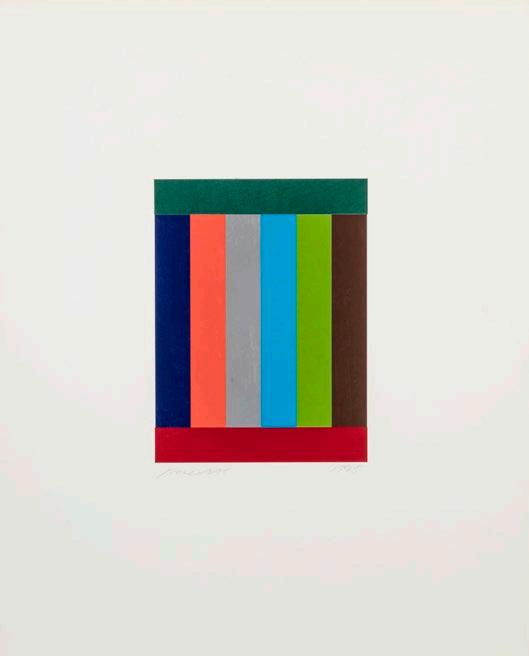
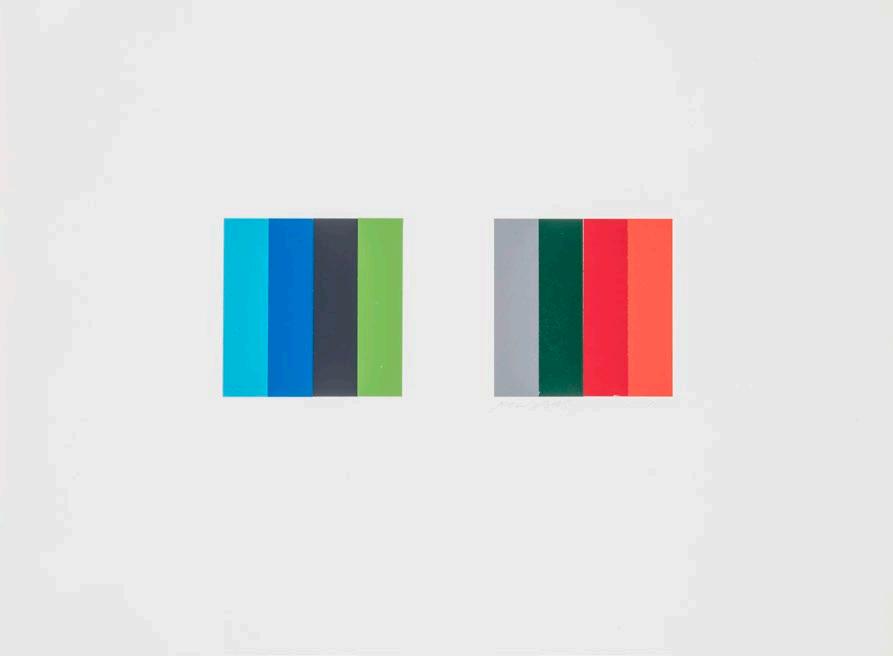
“I have actively pursued an understanding of colour in a way that no other artist has to my knowledge, and this had not been devoted to mastery. To be a master you have to stop thinking about it.”
- Jaan Poldaas
65
Jaan Poldaas
Horizon Paintings, Series 3 lacquer and enamel on cover stock paper signed and dated 1973 lower right; no.10 of 12 28.5 x 22.5 in
“In my first studio at 456 Spadina Ave, I spent the fall of 1972 and spring of 1973 experimenting with lacquer enamel on cover stock. The paints were left over from sign painting jobs, and the paper was cheap and convenient. These experiments culminated in what I have come to call “Horizon paintings, series 1 through 5.” Most of them were black lacquer and black enamel. The lacquer brushed roughly onto part of the paper, ending in a loose contour, and the enamel brushed more deliberately to a straight edge and
covering all the remaining white. Three categories of surface resulted: lacquer on paper, enamel on paper, and enamel on lacquer. The last being the blackest and glossiest. I was working on the premise that if one could isolate the phenomena of one area of paint overlapping another, one would be approaching an essential aspect of paint. This is quite obvious; the challenge was in the inevitable suggestion of composition and pictorial space. In finally titling these works as landscapes I presented my conclusion that two areas of paint on a single surface can’t escape having a degree of figuration.”
- Jaan Poldaas, From a letter to James D Campbell April 4, 1990
Auction Estimate: $4,000 - $6,000

Jaan Poldaas
Inverse Squares (Yellow on Blue) collage, enamel on paper mounted on card signed and dated 1991 lower margin; titled on the reverse; no. 5 of 12 16 x 20 in
“In Newtonian physics, the Law of Inverse Squares applies to electromagnetic radiation and gravity, and defines the intensity of forces acting at a distance as being inversely proportional to the square of the distance. If a light shining on a wall has a certain intensity at a given distance, then that intensity is divided by four when the distance is doubled. Newton discovered this principle in the seventeenth century and used it (along with his nascent calculus) to plot the paths of the planets. The principle itself is implicit in the laws of perspective, which were formulated about a century earlier by painters in Italy and Holland.
When it had become obvious, by the early 1990s, that perspective drawing was being taken over by machines, I involved myself nostalgically by making
several series of paintings that used a sequential square root variation of width to produce equal areas of different size and shape.
In each half of an Inverse Squares painting, there are four colours of equal area. These may be seen as a series of (deliberately approximate) squares, arranged one on-or-in another, with the respective relative side dimensions of 20, 1.732, 1.414, and 10. These numbers are the square roots of 4, 3, 2, and 1.
Each painting has red, yellow, blue and black areas on both sides. The in-to-out sequence is ABCD on one side and ABDC on the other. Each nominal colour is represented by two different pigments. The resulting composition has a figure-ground relation of each inner square to its two partial surrounds and a more basically graphic character in the central stripes. (In my opinion.)”
- Jaan Poldaas, 2014 (Artist’s notes, from the Jaan Poldaas Archive)
Auction Estimate: $2,500 - $3,500
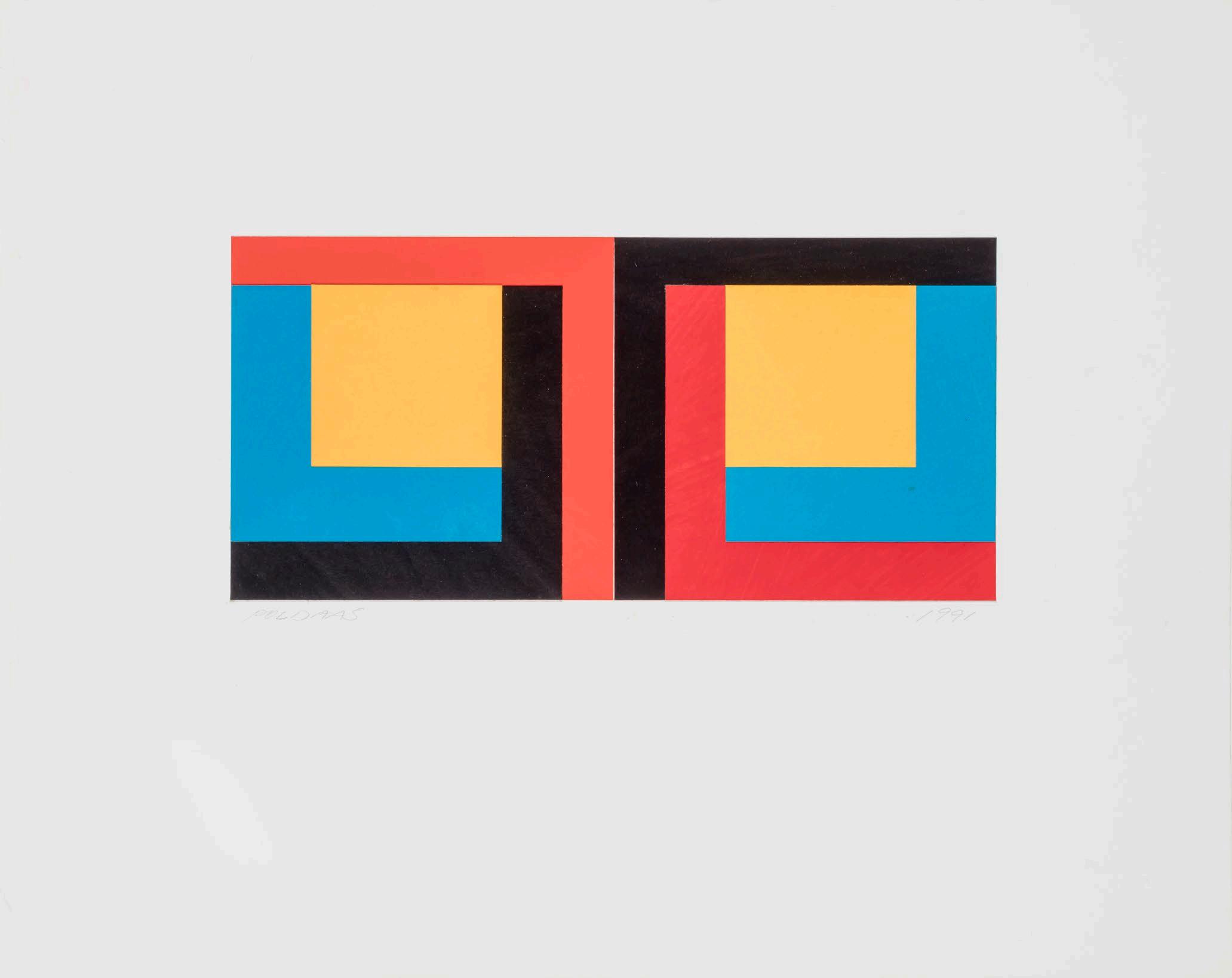
67
Jaan Poldaas
Square Composition (Black on Red) collage, enamel on paper mounted on card signed and dated 1990 in the lower margin; no. 10 of 12 16 x 13.5 in
In the catalogue for the Power Plant exhibition Abstract Practices, a survey in 1991 of contemporary abstraction in Canada with the emphasis on longstanding practice, James D. Campbell writes on the series Square Composition:
“The implacable logic, full conceptual resolution and visual immediacy that mark Poldaas’ practice, particularly with respect to what is still possible for colour within both painting and the shared horizon of its apprehension in the life-world, has long been recognized. His recent exhibitions in Toronto have
been exemplary in demonstrating how much colour has left to say in the idiom of a conceptually based abstraction. Doubtless, the same could be said for paintings like the Square Composition exhibited now at The Power Plant. Indeed, if the conceptual integrity of this work were not so strong, we might choose to differentiate the contribution of Poldaas on the basis of colour alone. Here, an algebraic framework for, and deeply personal sense of, colour - which has encompassed an environmental or “public” colour and now seems imbued with an intrinsic universality - is the creative capstone of this later, and more critical abstraction. Poldaas, a painter avowedly interested in “every aspect of colour and our responses to it” in his development of a colour-phenomenology, proffers a concept of colour that is somehow “inter-subjective” - that is, one not autonomous of the social world but somehow indissolubly wed to it.”
Auction Estimate: $2,500 - $3,500

68
Jaan Poldaas
Four Corners [Collage no. 6], 1993 collage, enamel on paper mounted on card signed lower margin and inscribed “6” upper right; no. 6 of 6
20 x 15 in
“In his new series Four Corners, Poldaas has succeeded in creating phenomenally restless objects which beguile us even as they induce reflection. Each painting is made up of a score of four-sided geometric shapes in four different colours: blue, red, grey and brown. These shapes fit together neatly like pieces in a colour puzzle. As we try to find order within their apparent chaos, Poldaas successfully frustrates every attempt we make at definitive solutions. The multiple juxtapositions of the planes of colour result in a compelling play between a flat, two-dimensional space and the space of Cubist geometry and, as such, the paintings refuse any one spatial interpretation.”
- James D. Campbell,
1991
Auction Estimate: $3,000 - $4,000

69
Jaan Poldaas
Nominal Four [Collage no. 7] collage, enamel on paper mounted on card signed and dated 1994 lower margin 20 x 15 in
Nominal Four is part of a series of paintings that use a sequential square root variation of width to produce equal areas of different size and shape:
“For followers of Jaan Poldaas the pattern of the “Nominal Four” series is a familiar and encouraging one: the artist, one of Toronto’s top abstractionists, takes another small but definitive step in an ongoing examination of colour and form. This time Poldaas starts with the primaries plus black and white, and
creates with them a palette of eight colours: a deep red, an orange red, a bright blue, a royal blue, an earthy brown, a sandy brown, a dark grey and a light grey. Each canvas features the same pattern of overlapping squares, two of them bisected horizontally, two split vertically, and can be read as a cube sitting inside a series of increasingly large frames. In each painting, each different space is assigned one of the eight colours. Forms appear and disappear, space approaches and recedes, vistas open and close, colours pulsate and fade. Once again, the artist asks us to really look at the building blocks of art and in doing so makes us see.”
- Kate Taylor, Globe and Mail, 1994
Auction Estimate: $2,500 - $3,500

70
Jaan Poldaas
8 Colours study (“O” GBNR), 1995 collage, enamel on paper mounted on card signed and dated 1995 in the lower margin 19 x 15 in
“My work since 1974 has separated colour as concept from colour as percept by using systems or definitions which are primarily non-visual to generate groups of colours. This separation has made visible the relation between “what is known” and “what is seen”.
-Jaan Poldaas, 1979
Auction Estimate: $2,500 - $3,500

71
Jaan Poldaas
12 Colour Pair Study collage, enamel on paper mounted on card signed and dated 1996 in the lower margin; 1 of 120 15 x 20 in
In his book Abstract Art in Canada, Roald Nasgaard includes a section on Poldaas, in which he states:
“The Twelve Colour Pair series (1997) are a kind of game of reward and punishment. It begins with the artist deciding on three shades each of four colours: red, green, blue and grey. The project is to make painting pairs in which each panel will be made up of four parallel vertical bands of colour selected from the twelve options (use eight, discard four). Poldaas worked out the paintings in studies using little coloured rectangles. For once, in selecting and arranging the four colours of his first panel,
he allowed himself to indulge his own tastes. But such irresponsible freedom was hard-won, because it demanded to be countered by inevitable consequences, the strictest of rules set in place to determine how the second panel would be composed, to ensure that it was a kind of opposite. “If I like the look of maroon, vermilion, sky blue and a middle grey together” in the first panel, according to the system the second panel had to follow automatically, whatever the results, even if they were “abhorrent.”
“You can’t have one without the other.” There were also rules for recycling the four colours that were left over from the eight that went into each pair, and for keeping the greens in use: a constant struggle of will and law. Of the thousands of possibilities for the Twelve Colour Pair series, Poldaas made 120 studies that yielded twelve painting pairs, one of which has been lost.”
Auction Estimate: $2,000 - $3,000

If a painting made it into Jaan Poldaas’ personal collection and onto to his walls, it signals an affiliation: deep respect for the artist’s mind, and integrity of their hand in paint. The lineup of the 35 pieces from the art collection of Jaan Poldaas and his late wife Penny Rose mostly consists of abstract works. There are works by the ‘third wave’ of Canadian abstract painters (Harold Klunder, Erik Gamble, Alex Coleman), works by other conceptualists or minimalists (Ric Evans, Richard Nonas) and notably includes a selection of representational paintings, such as the beloved portrait painter Lynn Donoghue (1953-2003), and legendary John Scott (19502022).
Each piece in a lineup which represents five decades of Canadian Art and art-making tells a story about painting in Toronto and its legacy: its affiliations, and exchanges. From the established abstractionists, like the Issacs’ Group and Sable-Castelli artists to Poldaas and his merry band of cohorts in their early days at A.C.T., Mercer Union, and Artists Review in the 1970s, to Poldaas’ later commercial success by the 1990s as a lifelong devotee to geometric abstraction and his conceptual, system-based origins in pursuit of the semiotics of colour.
Some of the paintings in Jaan Poldaas’ collection were traded for a particular work. Poldaas swapped a red-blueyellow-black painting from the sought after and widely collected False Target series (1991) for a large oil painting by the abstract turned figurative artist Will Gorlitz depicting outrageously sized red tomatoes in a night garden. Some of the paintings in the auction were gifts from one artist to another. Or the occasion of the marriage of Poldaas to Penny Rose. And some were acquired to commemorate a moment in Poldaas’ development, like an artwork as talisman. For example, Poldaas’ first museum show Four Painters at the AGO in 1976 with Ric Evans, or by collecting paintings from the artists named in the venerable New York critic Donald Kuspit’s discovery of Toronto’s “Exotic Modernism,” Poldaas amongst them, why he became a painter in the first place
Whether from Poldaas’ life-long confrere Ric Evans, collaborators like Robert McNealy, and Jaime Lyons, his mentors and predecessors like the analytic process painting artist, NSCAD based Garry Neill Kennedy; or studio mates like Harold Klunder, John Brown, and Richard Storms, or from the next generation of abstract practitioners (Clive D’Oliviera): all the works in the collection held meaning for the artist, and reflect Jaan Poldaas’ true admiration of paint, painting - and the great Canadian painters.




Brian Boigon
John Brown
Alex Cameron
Clive D’Oliveira
Tim Deverell
Lynn Donoghue
Ric Evans
Andy Fabo
Robert Fones
Erik Gamble
Oliver Girling
Will Gorlitz
Rae Johnson
Garry Neill Kennedy
Harold Klunder
Jamie Lyons
Robert McNealy
Richard Nonas
Roger Piotrow
John Scott
Richard Storms
Robert Youds
72
Ric Evans
Untitled watercolour signed and dated 1981 lower right 30 x 22.25 in
Ric Evans (b. 1946), Poldaas’ biggest influence, lifelong friend and confrère, is a geometric abstract painter known for creating a succession of relationships between his works in which colour and form of each painting are made from unique and playful combinations. Poldaas met Evans soon after leaving architecture school to pursue abstract painting, and the two young artists, with Robert Jacks, who was also based in NYC, got a studio on Niagara Street in Toronto. The artists stood out amongst their peers, and apart from the established Yorkville painters who didn’t really think what the young abstractionists were doing was painting (or art). The two began taking frequent trips to NYC where they found a place amongst the conceptualists and minimalists, like Sol LeWitt, and assisting for Lawrence Weiner. Their respective 50 decade long careers are deeply intwined, and there is a feeling between both artist’s oeuvres that they constantly were moving each other forward, though with different and equally distinct results in paint, sharing the same fundamental project.
Auction Estimate: $1,000 - $2,000

73 Ric Evans Sum C2 watercolour
signed, dated 1974 and indistinctly inscribed lower right; titled and dated June 1973 on the reverse; unframed
31.5 x 23.5 in
Auction Estimate: $1,000 - $2,000

and dated 1992 on the reverse; unframed 18 x 18 in
Auction Estimate: $900 - $1,200

75 Ric Evans
Untitled Study oil on paper signed and dated 1985 in the lower margin; dated 1985 to a gallery label on the reverse 5.5 x 5.5 in
Auction Estimate: $800 - $1,000

76
Richard Nonas
Canada Summertime oil on paper signed, titled and dated 1980 upper left; signed and dated on the reverse; unframed 23.5 x 20 in
This work by the Post minimalist American artist Richard Nonas (1936-2021) whose work can be found in the public collections of the Albright-Knox, Guggenheim and MOMA, came into Jaan Poldaas’ orbit in the summer of 1980 when Nonas showed two outdoor sculptures at the AGO in conjunction with an exhibition at Mercer Union: Canadian Word-Chaser Series (Installation). Poldaas, who was a founding member of Mercer in 1978, and went regularly to New York with Ric Evans to be amongst the minimalists and conceptualists, likely encountered Nonas in the 70s via Sol LeWitt, and their mutual friend the Australian colour-field painter, Robert Jacks, one of the four painters in the exhibition of the same name at the AGO in 1974, Poldaas’ first museum show.
Auction Estimate: $3,000 - $5,000

77
Robert Youds
Archive Painting oil on canvas signed, titled and dated 1988 on the reverse 36 x 36 in
In the 1980s, Poldaas rented a floor in a warehouse space on King Street West, which he shared with 5 other painters: Ric Evans, John Brown, Jamie Lyons, Richard Storms, and Robert Youds. This group of painters working alongside each other exchanged ideas and paintings. Youds, whose singular investigation of the material conditions of the pictorial eventually took painting into a realm outside of painting incorporating light, plexiglass and other non-paint materials, swapped this work for a Poldaas’ Entropy Series painting.
Auction Estimate: $2,000 - $3,000

Jaan Poldaas Entropy, 1982 enamel on board 63.75 x 14 in Not for sale with this lot.

78
Will Gorlitz
Untitled oil on canvas signed, dated 1990 and titled on the reverse; unframed 40 x 30 in
Poldaas exchanged one of the widely collected False Target series (1991) for a large oil painting by the abstractionist-turned-figurative artist Will Gorlitz (b. 1952) whose painterly approach to representational painting foregrounds visuality. This exchange signals their fraternity in paint (and likely Poldaas’ admiration of the reds and yellows), overcoming the divide, and occasional battle, between two schools in Canadian painting.
Auction Estimate: $2,500 - $3,500

79
John Brown
Abstract oil on board signed and dated 1990 on the reverse; unframed 18 x 16 in
Fellow abstractionist and studio mate, John Brown (1953-2020), was known for a slow painting process of applying oil paint to a panel and scraping it off to leave a residual history of the work, taking up to a year to create some of his paintings. Seemingly an opposite approach to Poldaas’, who decided on the parameters of a painting before execution, worked serially, and sometimes on several canvases at once. They shared a dedication to a deeply meticulous practice. Brown met Poldaas at Mercer Union, where he became active and a board member in the 1980s.
Auction Estimate: $1,000 - $1,500

80
Tim Deverell
Untitled oil on canvas signed on the stretcher on the reverse; unframed; sold with the related study “Untitled” (oil on canvas, signed and dated 9/05 on the reverse - 8 x 8 ins.) 42 x 42 in
Known for an all-over saturation of painted surface, Tim Deverell (b. 1939), a member of the Arts Student League NYC, started exhibiting in New York the 1960s. His abstract style developed through landscape and figuration towards an urban iconography. Forms vary between a non-specific array of geometries to recognizable elements suggesting populated cityscapes or crowds. Particularly drawn to this convergence of abstraction and the figure, Penny Rose collected this large, stunning canvas, which hung in the entrance way to her and Poldaas’ home. Deverell gifted Rose with a small study of the work to accompany the large-scale canvas.
Auction Estimate: $700 - $900


81
Richard Storms
First Cloud oil on canvas signed, titled and dated 1987 on the reverse 16 x 20 in
These two works by painter Richard Storms (b. 1954) were part of a trade for Poldaas’ Green White Red Entropy. Storms was one of the 6 painters, and Jaan’s studio mate, who shared a floor of a warehouse turned painters’ incubator on King Street West during the 1980s.
Auction Estimate: $800 - $1,000

East View oil on canvas laid on board signed, titled and dated 1984 on the reverse; unframed 14 x 13.75 in
Auction Estimate: $600 - $800

83
Alex Cameron Solstice Eve oil on board signed, titled and dated 1989-90 on the reverse; unframed 18.25 x 14 in
Poldaas notably owned three landscape paintings by Alex Cameron (b. 1947), a ‘third generation’ Canadian abstractionist, former studio assistant to Jack Bush, and Clement Greenberg crony. Cameron, a master painter who is known for a semi abstract style to plein air landscape painting, and impasto application of paint, was a fellow artist in the Constin & Klintworth gallery. The feeling between the two artist must have been mutual: Cameron owns 1 of the 16 Poldaas’ canvases from his ‘come back’ show after a decade away from exhibiting. The show sold out before it opened at Birch Libralato in 2011.
Auction Estimate: $2,000 - $4,000

Alex Cameron
Shoreline (Georgian Bay) oil on canvas
signed and titled on the stretcher; signed, titled, dated 1988 on the reverse; titled and dated on a gallery label on the on the reverse 16 x 12 in
Auction Estimate: $2,000 - $4,000

85
Alex Cameron
signed, titled, dated 1991 on the reverse, titled and dated on a gallery label on the reverse 30 x 40 in
Auction Estimate: $3,000 - $5,000

86
Clive D’Oliveira
Colour Bar ‘B’ #2 acrylic on canvas signed, titled and dated 2000 on the stretcher and further titled and dated on a gallery label on the stretcher on the reverse; unframed 32 x 28 in
This painting from the Colour Bar series, a homage to Jaan Poldaas, from a show at Leo Kamen in 2000 was presented as a gift to the artist by Clive D’Oliveira (1955-2019). D’Oliveira had a deep admiration for the senior abstractionist who he considered his mentor, and whose work his derived from, but never quite achieved the status of disciple. To the surprise of the younger artist, Poldaas approved and hung the painting at the entrance to his live/work studio in the former John Abell Factory so he could sit and think about the bars of colour: “This is a good painting.”
Auction Estimate: $1,500 - $2,500

87
Robert Fones
Jaan Poldaas H mixed media on paper signed, titled, dated November 30, 1992 with annotations and further annotations on the reverse; unframed 7 x 5.25 in
Canadian visual artist Robert Fones (b. 1949) known for his work in a variety of media combining elements from popular culture and design, such as packaging, pictograms and letterforms, with his investigations into geological, cultural, and industrial histories, is also known for his critical investigations into the materiality of art. In 1993, he wrote a C Magazine essay investigating the relationship between colour and technique: “Local Colour: Colour and technique in the work of Joanne Todd, Greg Curnoe, and Jaan Poldaas.”
Auction Estimate: $800 - $1,000

88
Lynn Donoghue Still Life watercolour inscribed “For Jaan and Penny, Christmas 2001, with love Lynn” lower right 19.25 x 25 in
This ripe still life, a wedding gift from beloved Canadian portrait painter, Lynn Donoghue (1953-2003), was hung in Poldaas and Rose’s home. Donoghue, a dear friend of the couple, claimed the title of matchmaker, having set them up at the Cameron House where painters, figurative and abstract alike, met every weeknight for a mandatory salon style 5 à 7.
Auction Estimate: $600 - $800

89
Rae Johnson Manitoulin Island watercolour signed, dated 2009 and inscribed “Feb. 2010. Happy 60th Penny. A milestone. Many more! The best is yet to come. Rae” on the reverse; unframed 9 x 12.25 in
The celebrated Canadian figurative painter Rae Johnson (1953-2020), and ChromaZone co-founder was a mutual friend of Poldaas, and his late wife, Penny Rose, and one of the Cameron House crew, where the couple met. This painting was gifted to her dear friend.
Auction Estimate: $400 - $600

Jamie Lyons Saugeen Abutment acrylic on printer’s block signed, titled and dated 1986 on the reverse; unframed 10 x 14 in
Jamie Lyons (1948-?), one the A.C.T. (Artist Cooperative Toronto) artists began exhibiting with Poldaas in the 1970s and grouped into the younger abstract painters with conceptualist and system-based leanings. Notably the 1978 show at Harbourfront Art Gallery, Common Factors: Michael Balfe, Ric Evans, Jamie Lyons, Robert McNealy and Jaan Poldaas. Lyons, whose work moved into “pure” abstraction, was deeply respected amongst his peers, especially for his use of colour by Poldaas, with whom he also shared studio spaces with for decades. Lyons never found commercial success, or recognition in the Canadian abstract canon, and tragically towards the end of his life painted in a kind of obscurity.
Auction Estimate: $400 - $600


91
Andy Fabo
Untitled (Eye, Spoon and Factory) ink on wood signed and dated 2002 lower right 11.25 x 8.5 in
This work by Andy Fabo (b. 1953), the ChromaZone co-founder influential in reviving the body as subject matter in Canadian painting (1980-85) – i.e. the opposite camp of Poldaas’ and Evans and the other Canadian abstractionists, was a particular favourite of Penny Rose, and hung as one of the few non-abstract works in their home.
Auction Estimate: $800 - $1,200

Garry Neill Kennedy #11 CAMEL TAN (colour your world) from THE MIDDLE EAST (J.P) acrylic on canvas signed, dated 1992 and titled on the stretcher on the reverse; unframed 12 x 16 in
Garry Neill Kennedy, CM, RCA (1935-2011) was a Canadian conceptual artist and educator, appointed president of NSCAD at the age of 32 in the late 1960s. A legendary figure in Canadian art both for his artistic legacy and impact on Canadian artists at the helm of NSCAD, Kennedy invited Poldaas in 1980 to exhibit the work he is best known for from the first decade of his career: EG Series (1978-2011) in Nova Scotia. The inscription on this painting, which references the colour of sand to Saudi Arabia (Poldaas spent a year there in 1977) and dedicates the work to a fellow conceptualist.
Auction Estimate: $300 - $500

Estimate: $1,000 - $1,500


94
John Scott
Lot 16 Bar Napkin Drawings
10 drawings (Sharpie on cocktail napkins and paper) including:
8 Sharpie drawings on cocktail napkins (each 5 x 5 in);
1 Sharpie drawing on a cocktail napkin (6 x 6.25 in);
1 Sharpie drawing on paper (11 x 8.5 in); each unframed
The legendary artist John Scott (1950-2022) was a regular at Lot 16, the tiny bar opened by Penny Rose on Queen Street West, in the early 2000s, which Poldaas, trained in architecture, designed. The Cameron House crew migrated first to The Gladstone, then to Lot 16. The sharpie napkin drawings series, of which half are available on auction, tells the story of a day Scott sat with Rose’s daughter and recast the characters sitting with them at the bar into his visual world: Penny Rose is drawn as a bunnie, serenaded in various ways, in black ink; and Poldaas is drawn by Scott as a levitating visionary, hovering over the bar and Queen Street West.
Auction Estimate: $700 - $900


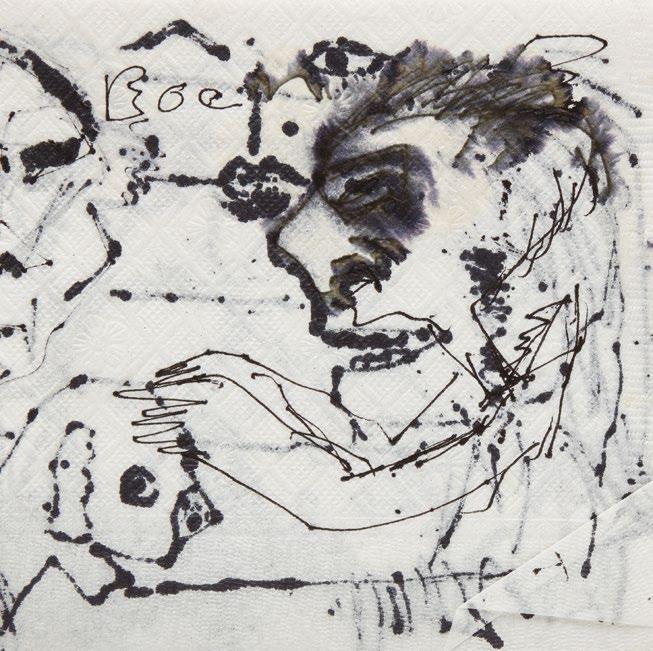

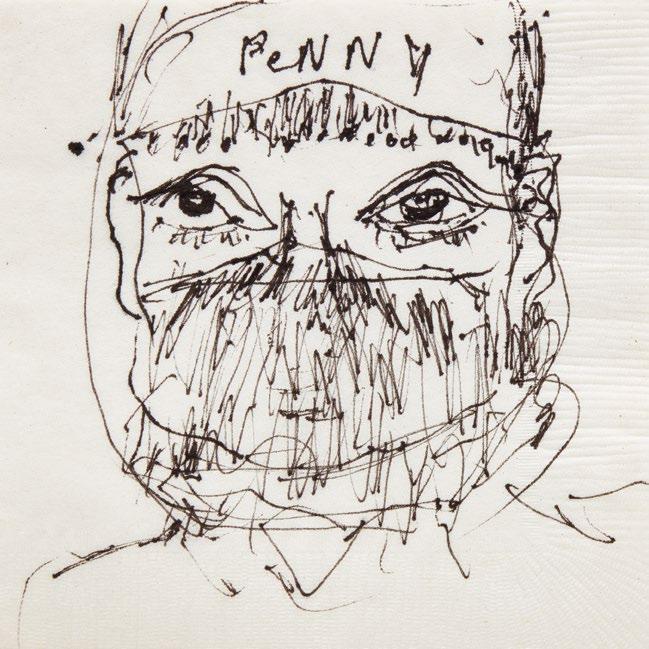



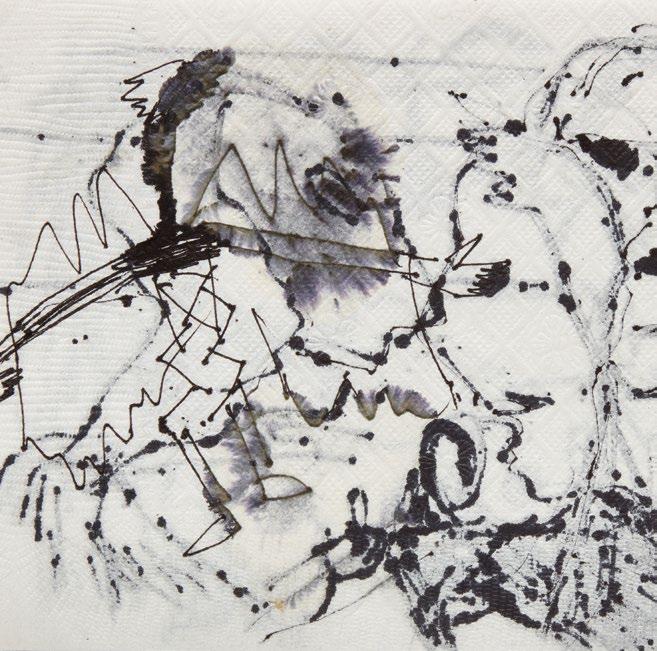
95
Roger Piotrow
Untitled (Grey Grid Study) serigraph signed, dated “1976” and numbered “1/6” in the lower margin; unframed 24 x 18 in ( 61 x 45.7 cm ) ( sheet )
In 1983, Jaan Poldaas was curated into another important group show, Rational Alternatives at The Art Gallery at Harbourfront (the precursor to The Power Plant). The exhibition was about the expression of reductivist aesthetics in paintings by five artist: Kim Andrews, Peter Kolisnyk, Roger Piotrow, Poldaas, and Françoise Tounissoux. Poldaas exhibited paintings from three series: XY, Frieze, and [2,1,3]/5 Colours. Notably all of Jaan’s work in the exhibition was collected by major institutions such as the National Gallery of Canada. What remained from the show was a work by fellow reductivist, Piotrow.
Auction Estimate: $400 - $600

Robert McNealy Neandertal; Habilis (from the Skullduggery series) two mixed media works on paper - “Neandertal ” (4.5 x 4 in - signed, titled and dated 2005 on the reverse); - “Habilis” (6 x 5.5 in - signed, titled and inscribed “first attempt, 2011” on the reverse) 6 x 5.5 in
Poldaas was greatly influenced by his relationship with Robert McNealy, whom he met soon after he left architecture school to pursue a career in painting in 1972. McNealy was an active member, and maverick, of the Toronto Art scene in the 1970s, was one of the founders of Mercer Union from the A.C.T., exhibited and shared many studios with Poldaas (Common Factors, 1978). McNealy left Toronto for the West Coast. Apparently Poldaas’ former gallerist, Robert Birch, brought these works to Poldaas from McNealy’s Skullduggery show at Grunt gallery in Vancouver in 2011.
Auction Estimate: $200 - $400


97
Erik Gamble
Untitled (Landscape) watercolour signed and dated “Dec.23/1985” lower right 8.5 x 11.5 in
Erik Gamble (1950-2007), by his mid-20s, had earned recognition by exhibiting at the David Mirvish Gallery alongside prominent American and Canadian abstract artists. Known for expressionistic colour abstraction and as a “pure” abstractionist, Gamble also ventured into landscape and figurative subjects. He was one of the senior artists at Constin and Klintworth, a gallery which Poldaas joined in the mid 80s when he gained commercial success. Notably, of the work from the roster of gallery artists, all abstract painters in Poldaas’ collection are examples of their landscapes, such as this one.
Auction Estimate: $500 - $700

98 Oliver Girling
New Westminster Harbour watercolour signed and dated 2004 lower left; signed, titled, dated and inscribed “To Penny with love on your 60th in memory of the blue skies of Skopelos” on the reverse; unframed
11.25 x 15.25 in
A gift from Oliver Girling (b. 1953), another artist from the ChromaZone collective with decades long, but separate relationships with both Poldaas and Rose. Despite their mutual friends, Poldaas and Rose did not meet until the late 1990s.
Auction Estimate: $400 - $600

99
Harold Klunder
Ivory Coast lithograph signed, titled, dated 1979 and inscribed “State Proof” with the printer’s blindstamp in the lower margin; unframed 24 x 17.5 in
Harold Klunder (b. 1943), who is known for a decadelong body of work evocative of the possibilities of paint, lived next door to Jaan Poldaas’ studio in the 1970s and early 1980s at #1 Niagara Street. It was Poldaas’ first and notorious studio space of the unholy three: initially shared with Ric Evans and Robert Jacks. Poldaas greatly admired the abstractionist. At the time, Klunder a senior artist, was one of the established Sable-Castelli artists. Klunder eventually moved to the countryside, then to Montreal, but the two artists remained terrific friends engaged in a lifelong dialogue about art, artists, and the possibilities of paint.
Auction Estimate: $500 - $700

100
Brian Boigon
Cacti and Their Stimulants mixed media print signed, titled and numbered 10/10 in the lower margin 40 x 29 in
When Poldaas married Penny Rose, their lives and art collections merged. This large work by Brian Boigon, an artist, data architect and philosopher whose works spans disciplines, such as quantum mechanics, was one of the few pieces that remained on the wall at the entrance to their home, and Jaan’s live/work studio, in the now demolished John Abell Factory in Toronto.
Auction Estimate: $700 - $900
